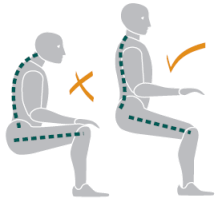Blog
6 Tips For Improving Posture

Having good posture is something that takes consistent work. Poor posture can be caused by habits from everyday activities such as sleeping on the wrong kind of mattress, sleeping with the wrong kind of pillow, sitting in office chairs, looking at the computer, driving, looking at your cellphone, etc. You may be so used to your habits that involve poor posture that you're starting to experience back pain. Fortunately, the main factors affecting posture and ergonomics are not difficult to change.
Here are a few guidelines to improve posture, especially for those of you who spend most of your days sitting at a desk
1. Learn the warning signs of back pain caused by poor ergonomics and posture.
Back pain can be caused by many different factors, so it can be hard to tell when it stems from poor posture or ergonomics. Pay attention to your back pain, if you notice that it gets worse during certain times of the day or week (for example, after a long day sitting in your office chair in front of the computer) then that may be due to poor posture or ergonomics.
2. Get up and move around.
The longer you stay in the same position the more your muscles will tire. You will find yourself slouching which puts unneeded pressure on your neck and back. Change positions frequently, and take breaks from sitting every half hour by getting up to stretch, stand, or walk around.
3. If you have to sit, sit with the proper posture.
Use your chair's features to your advantage. Sit up straight. Align your ears, shoulders, and hips in a vertical line. Another position you can switch to is to lean forward with a straight back using the back support of the office chair to ease the work on your back muscles. Do not cross your legs unevenly or lean your weight to one side, or tilt your head too far up or too far down.
4. Use posture-friendly technology to your advantage.
Supportive ergonomic tools can help take the strain off of your spine. Ergonomic office chairs or chairs with an adjustable back support should be used at work. Use the lumbar support in your car (if that is an option). Footrests, a towel, or a small pillow can be used while sitting in an office chair or while driving as well. Use purses, bags, backpacks, and briefcases that are designed to minimize the strain on your back.
5. Exercise
Regular exercise will help your body to stay strong. There are many specific exercises and stretches you can do to help maintain good posture.
6. Wear supportive shoes
If you stand most of the day, avoid wearing high-heeled shoes. This can affect your body's center of gravity and change the alignment of your entire body. You can also place a rubber mat on the floor to improve comfort and offer additional support.
Remember that good posture will take work. Regular chiropractic care is also a great way to keep your spine healthy so don't forget to schedule your next adjustment as soon as possible.
‹ Back








